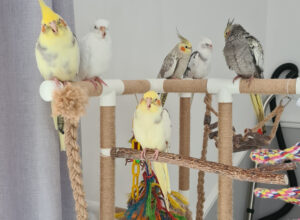Key Takeaways
It’s very important to create a stimulating and comfortable environment for our feathered friends. One crucial aspect of this is choosing the right perches. Not only do they provide a place for your cockatiel to rest, but they also play a vital role in their overall health and well-being.
Understanding the Importance of Perches
Perches are more than just a resting place; they are essential for your cockatiel’s foot health, exercise, and mental stimulation. A variety of perches in the cage encourages natural foot movement and grip adjustments. Both are crucial for preventing foot sores (bumblefoot) and arthritis.
Types of Perches and Their Benefits
There are several types of perches available, each offering unique benefits:
- Natural Wood Perches: Mimic the natural environment and help in maintaining healthy feet.
- Rope Perches: Soft and flexible, they provide a different grip and can be shaped.
- Calcium or Mineral Perches: Serve a dual purpose of perching and beak trimming.
- Plastic or Acrylic Perches: Easy to clean, but should be used sparingly.
Comparison of Perch Types
| Type of Perch |
Benefits |
Considerations |
| Natural Wood |
Mimics natural habitat, good for feet |
Must be untreated and safe wood type |
| Rope |
Flexible, soft on feet |
Needs regular cleaning to prevent bacteria |
| Calcium/Mineral |
Beak health, adds dietary minerals |
Can be rough on feet if used exclusively |
| Plastic/Acrylic |
Easy to clean, durable |
Not suitable for constant gripping |
Selecting the Right Size and Texture
It’s crucial to choose perches that are the right size for your cockatiel’s feet. The diameter should allow your cockatiel’s toes to wrap around the perch comfortably, without overlapping or being too straight.
Perch Size Guide
| Bird Size |
Perch Diameter |
| Small (Cockatiels) |
1/2 to 3/4 inch |
Texture variety is also key. Smooth perches are comfortable, but adding textured perches helps keep nails trimmed and provides sensory stimulation.
Placement and Variety
Proper placement of perches in the cage is essential. They should be placed at different heights and orientations to encourage movement and exploration. However, avoid placing perches directly above food and water dishes to prevent contamination.
Maintenance and Hygiene
Regular cleaning of perches is vital to prevent the buildup of droppings and bacteria. Natural wood perches can be scrubbed and dried in the sun, while rope perches may require more frequent replacement.
The Role of Perches in Cockatiel Care
Perches play a significant role in various aspects of cockatiel care:
- Exercise and Play: Perches of different shapes and sizes encourage physical activity. For more on cockatiel exercise and play, visit Cockatiel Exercise & Play.
- Mental Stimulation: Changing the arrangement of perches can keep your cockatiel mentally stimulated, preventing boredom. Learn about Cockatiel Exercise & Play here.
- Health Monitoring: Observing how your cockatiel uses its perches can help in identifying potential health issues. Find our more on identifying cockatiel illnesses.
Conclusion
Choosing the right perches for your cockatiel is a blend of understanding their physical needs and providing a stimulating environment. By offering a variety of perches, you contribute significantly to your cockatiel’s health, happiness, and longevity. Remember, a happy cockatiel is an active and engaged one!
For more comprehensive guides on cockatiel care, explore the essential aspects of
Cockatiel Care Basics and delve into the specifics of setting up the perfect
Cockatiel Cage. Your feathered friend deserves the best, and it starts with the simple choice of the right perches.

